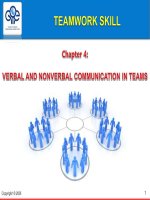Lecture Essay writing & presentation skills - Lecture 27: Non-verbal communication in presentation
Bạn đang xem bản rút gọn của tài liệu. Xem và tải ngay bản đầy đủ của tài liệu tại đây (295.05 KB, 45 trang )
Lecture 27
Nonverbal
Communication in
Presentations
Recap
•
How to prepare, make and deliver
presentation effectively?
Introduction to
Communication
•
•
Communication in general is process of:
–
Sending
–
Receiving
Messages
These messages enable humans to share:
–
Knowledge
–
attitudes, and
–
skills.
Introduction to
Communication
•
Communication
is
composed
dimensions –
–
Verbal Communication
–
Nonverbal Communication
of
two
Presentation skills,
conversation skills and
writing skills are the three keys
to effective communication.
The Lecture defines some tips
for using non verbal
communication to improve your
presentation skills.
Components of
Communication
Verbal Messages
the words we choose
Paraverbal Messages
how we say the words
Nonverbal Messages
our body language
Verbal Messages
Effective Verbal
Messages
1. Are brief, concise, and
organized
2. Are free of jargon
3. Do not create
resistance in the
listener
Categories in Non-Verbal Messages
Facial Expressions
•
A face can light up with:
•
enthusiasm
•
energy
•
approval
•
express confusion or boredom
•
frown with displeasure
•
eyes telegraphing joy
•
sadness
•
anger
•
confusion
Categories in Non-Verbal Messages
Postures and
Gestures
•
•
•
•
Warm
openness
Cold rejection
Feeling of
anticipation
Feeling of
inflexibility etc
Paraverbal Messages
•
•
Messages that we transmit through the
tone, pitch, and pacing of our voices.
It is how we say something, not what
we say.
According to the social
anthropologist, Edward T. Hall,
in a normal conversation between
two persons, less than 35% of the
social meanings is actually
transmitted by words. So, at least
65% of it is conveyed through the
body
(non-verbal channel).
Definition of Nonverbal
Communication
•
Non-spoken context within where all
face-to-face communication takes place.
•
Every
conscious
or
subconscious
behavior is covered with meaning without
which all verbal communication would be
ambiguous.
Nonverbal Communication
•
Non-verbal communication includes:
–
Pitch
–
Speed
–
Tone
–
Voice volume
–
Gestures
–
Facial expressions
–
Body posture
–
Stance/ Attitude
Nonverbal Communication
•
It also includes:
–
Touch
–
Glance
–
Vocal tone
–
Pause (silence)
–
Intonation
–
Smell
–
Word choice and syntax
Have you ever heard anyone
say;
His actions spoke so loudly I
couldn't hear what he said?
A Small Exercise
So What Does This Mean?
•
Can I help!
•
Trust me!
•
You’re in good
hands!
So What does This Mean?
•
Dejected
•
Disappointed
•
Lost it!
So What does This Mean?
•
So tell me more!
•
Open
•
Accepting
•
Welcoming
How to work on
Nonverbal
Communication during
Presentations?
First Impressions
•
You have only a few seconds to make a
good impression. So
make your
“audience" at the centre of the universe:
–
face them
–
give direct eye contact
–
palms outwards
–
open arms
–
a big smile and a firm
–
but not bone-crushing handshake
First Impressions
•
•
First impressions are also about your:
–
Dress
–
Hair
–
Shoes and
–
Air of confidence
Be aware that others are rushing to
judgment about you - especially important
if you are going for a PRESENTATION!!!
Eye contact
•
Eye
Contact
helps
indicates
your
interest in the people in the audience.
•
It increases your credibility.
•
When you make eye contact with people
in
the
audience,
you
increase
your
chances of getting your message across.
Eye Contact
•
Eye
contact
helps
you
establish
a
connection with the audience.
•
When you make eye contact with people
as you are speaking, you build one to one
bonds with them.









